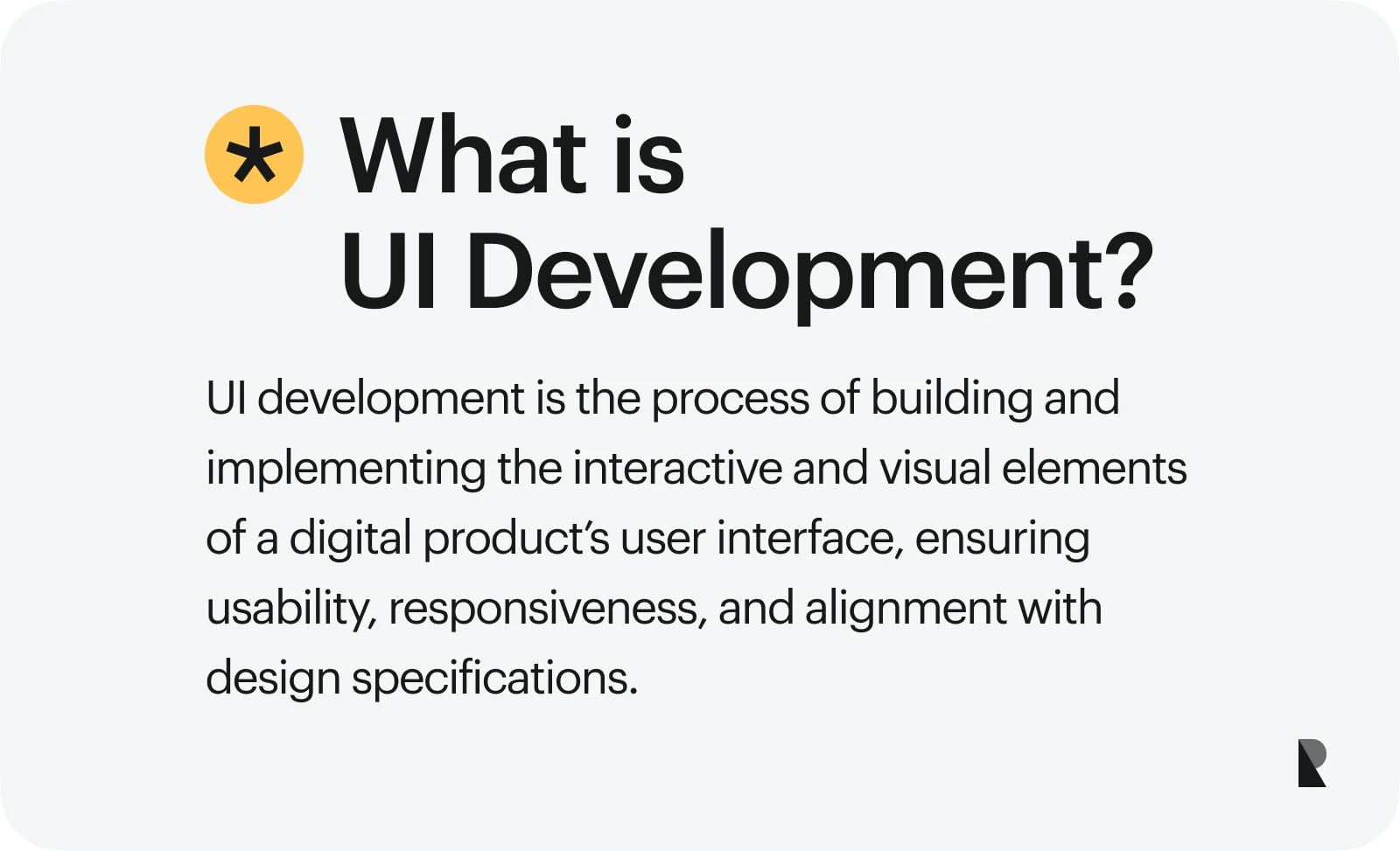
The tech world today offers numerous options and choices for users. A typical user interacts with new designs in the form of mobile applications, websites, and software. However, due to the fast-paced environment and demanding nature of their work, users expect these experiences to be useful and satisfying. This is where professionals who design and develop user interfaces step in.
The practice of building, designing, and implementing the visual and interactive elements of a digital product or service is referred to as UI development. The visual, aesthetic, and functional aspects of an interface are all important for the overall user experience, as they contribute to a satisfying interaction.
However, good UI design is more than just visuals. It ensures easy navigation, reduces confusion and frustration, and helps users accomplish their tasks quickly and efficiently. Without paying attention to good UI design, even the best products risk losing their customers.
For companies aiming to scale their digital products, design isn’t just about visuals — it’s about conversion, retention, and trust. Collaborating with an experienced UI & UX design agency helps transform interface design into a strategic advantage, aligning user behavior insights with measurable business goals.
In this article, we explore UI design and development and the core responsibilities of UI developers. We also share essential tools and technologies that can help in the process and crucial tips for aspiring UI developers.
Read along as we dive into the world of UI design and development.
What Is UI Design?
UI design focuses on the design elements that shape the look and feel of a product or service. Whether creating websites or mobile applications, UI designers focus on several essential aspects that make the design simple, clear, and easy to interact with.
What is UI Design?
User interface (UI) design is the process of creating simple, efficient, usable, and user-friendly products and services, particularly in the digital environment. UI design focuses primarily on clarity in design, along with the levels of user engagement and satisfaction.
Good UI design is crucial for the success of a product or service, particularly in the digital environment. UI designers put in a lot of thought, effort, and research when creating interactive layouts for products and services. The goal is to help users accomplish their tasks as they interact with the design.
However, this goal cannot be achieved if users are not satisfied with their interaction. This is where the emphasis on usability and user engagement is important. Exemplary user interfaces keep users engaged and provide a comforting experience.
UI developers need to consider the key elements when designing a good interface. Some important elements that guide the creation of effective user interfaces include buttons, typography, color, spacing, and positioning.
Careful placement, positioning, and spacing of elements is necessary to present the correct information at the right time. Thoughtful use of colors and cautious design of buttons provide an enriching experience and help them focus on their tasks. Similarly, typography ensures readability and makes the content understandable.
UI vs. UX Design: Key Differences
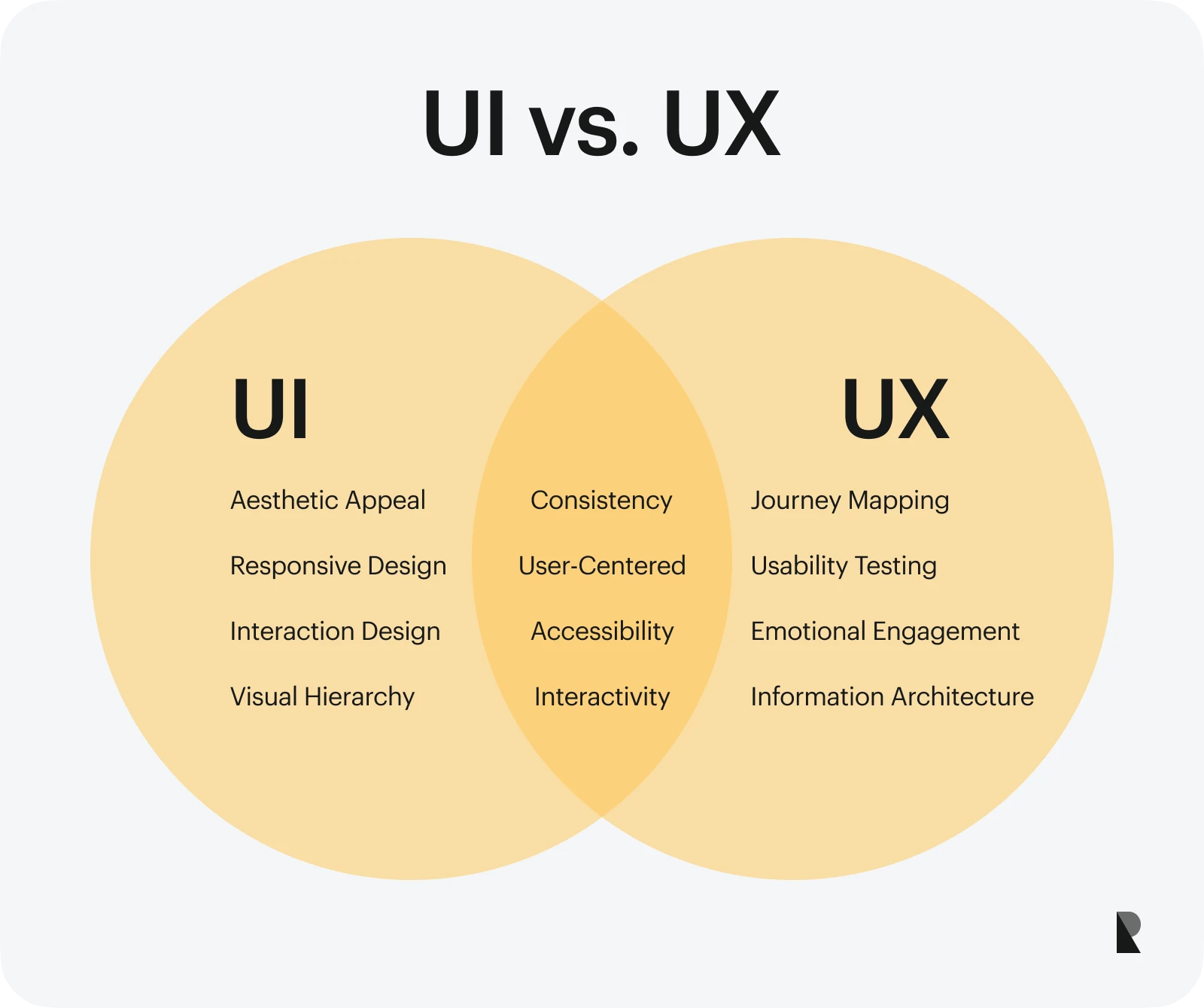
User interface (UI) and user experience (UX) design are often used together and, sometimes, interchangeably. However, these two practices focus on different parts of the design process and have varying goals. This does not mean that there is no overlap. UI and UX design have aspects in common, but the underlying goals are different.
UI design is concerned with creating visually appealing interfaces and the look and feel of products. UX design, on the other hand, focuses on the user flow and the overall experience that a user goes through when interacting with a design.
Some important UI tasks include designing buttons, choosing the right fonts, and picking appropriate color palettes. These tasks focus on the details that ensure consistency in the design and also improve the overall appearance of a product.
UX design, on the other hand, includes tasks such as creating a user flow, mapping out the user journey, and building wireframes. UX design focuses more on the steps users might take or their paths to accomplish their goals.
It is important to note that for a digital product to succeed, both UI and UX design must work together. This also means that UX designers and UI developers need to collaborate to ensure that a product is functional, useful, and visually appealing.
Core Responsibilities of a UI Developer
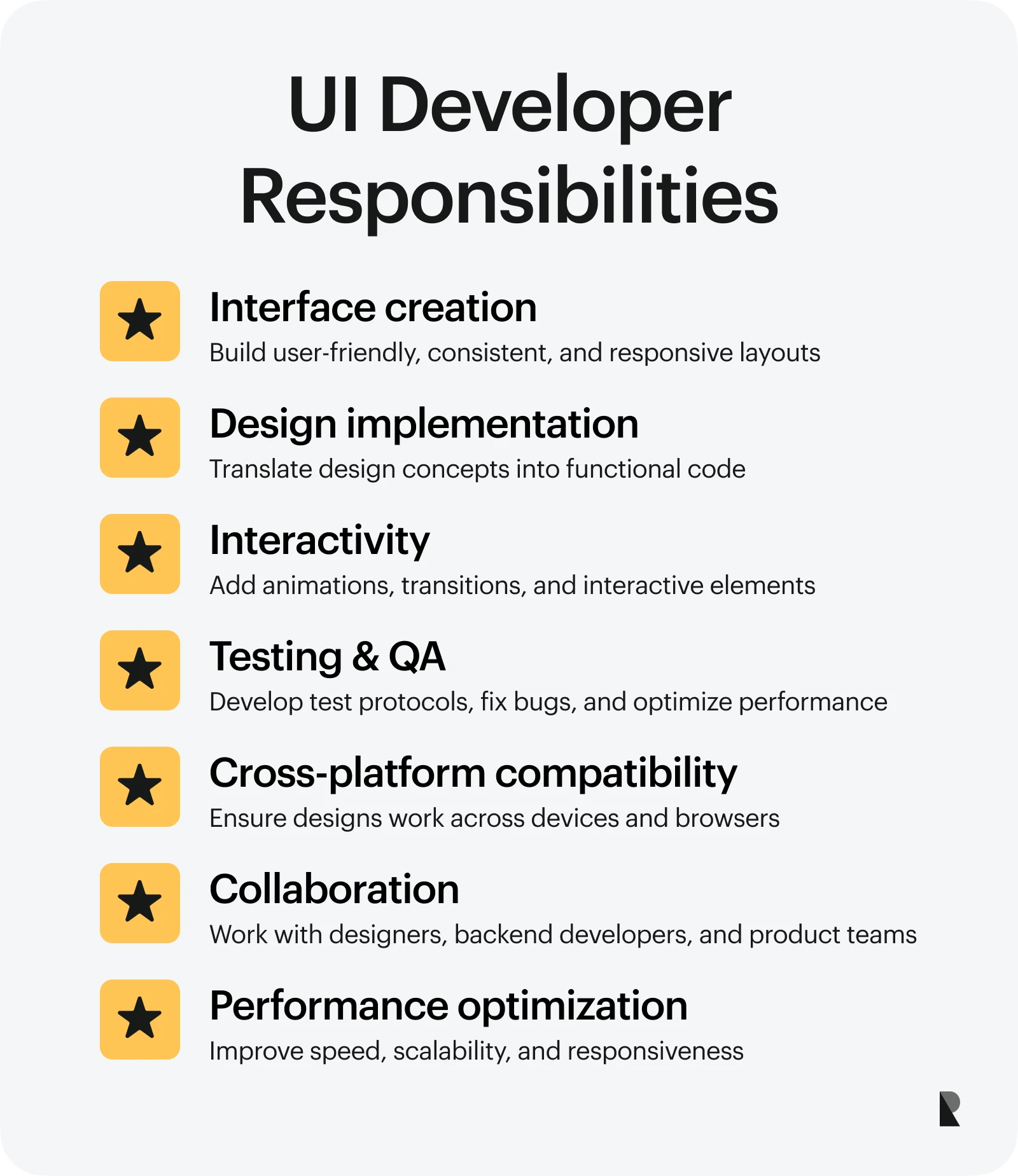
UI developers are critical in transforming ideas into reality and bringing designs to life. They are responsible for introducing innovation in designs and ensuring that the products are functional. The primary focus of UI professionals is to develop user-friendly interfaces that are consistent, appealing, and responsive.
Important responsibilities—or duties—of UI developers include implementing design ideas and creating interactive interfaces. They are also responsible for coding layouts and developing test protocols to ensure the designs are functional on different platforms and devices.
Along with introducing interactive elements and building new features for digital products and services, UI developers also handle quality assurance of the designs. This means that they test the products, fix bugs as they arise, and optimize performance. Therefore, the role of UI developers is to keep the designs efficient and valuable for the end users at all times.
Another important aspect of UI developers’ jobs is collaboration with other developers, designers, product managers, and marketing professionals. UI developers work closely with designers to translate their creative ideas into code and ensure feasibility. They also work with backend developers to improve the functionality and interactivity of designs.
For all modern businesses, hiring skilled UI developers ensures that the products not only look great but also perform well, especially when working with the best UI/UX design companies.
Common Tools and Technologies Used in UI Development
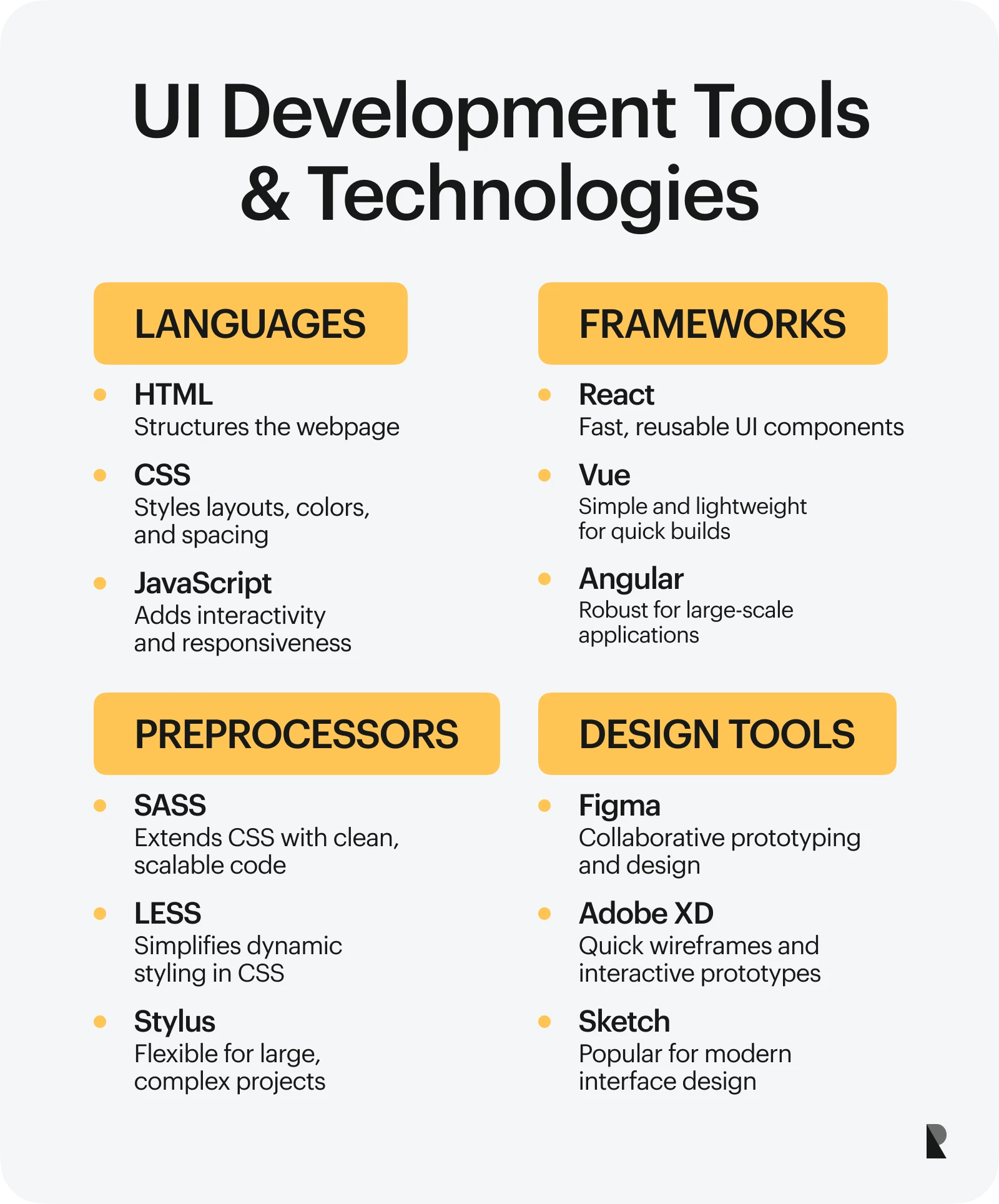
User interface development is a specialized process that requires several tools and technologies. UI developers use many tools to make their process smooth and efficient. These tools help visualize designs, make products functional, and ensure the reuse of design elements.
From coding with programming languages to using frameworks and preprocessors, UI tools play a vital role in web development and mobile app projects. These tools help a front-end developer build friendly interfaces that are responsive, cross-browser compatible, and easy for end users to use.
Some crucial categories of tools and examples are discussed below.
Essential languages
Programming languages are essential for building any interface, whether for web or mobile applications. These languages define the rules and also help structure and style the interface. Some crucial languages for UI developers are as follows.
- HTML, or Hypertext Markup Language, defines the structure of a webpage and is nothing short of a backbone for any digital product.
- CSS, or Cascading Style Sheets, works in conjunction with HTML and helps style the webpage using layouts, colors, spacing, and interactive elements.
- JavaScript is critical for interactivity in digital designs. It allows users to engage with dynamic and responsive elements.
Important frameworks
Along with programming languages, frameworks provide UI developers with a way to structure and design applications efficiently. They also speed up the development process while ensuring consistency and reuse of design elements. Some essential frameworks are as follows.
- React is widely used by UI developers as a fast, scalable, and efficient solution for using and reusing UI components.
- Vue offers a simple approach to design, making complex projects easy to manage in a short timeframe.
- Angular is used for more complicated projects where large-scale development and iteration are essential.
Preprocessors
Preprocessors are critical in extending the functionality of programming languages and frameworks. These tools help manage and scale stylesheets and streamline the development workflow. Some critical workflows include the following.
- SASS, or Syntactically Awesome Style Sheets, is an extension of CSS that helps streamline the styling process and creates clean code.
- LESS, or Leaner Style Sheets, helps simplify the design process, particularly when adding dynamic features and interactive elements to CSS.
- Stylus is known for its flexibility and efficient management of styles in large, complicated design projects.
Design tools
Design tools help UI developers visualize, refine, and realize ideas. These tools serve as a bridge between the creative phases of the design process and coding. They also help create interactive prototypes that can be tested with real users before moving to the final phases of UI development. Some important design tools are as follows.
- Figma is a popular collaborative design tool that helps designers and developers work together and create easy-to-use prototypes.
- Many front-end developers use Adobe XD to create wireframes and prototypes for mobile and web applications quickly.
- Sketch is a powerful design tool known for its utility in creating modern and user-friendly interfaces.
All the tools and technologies available to UI developers help them in different process stages. The table below summarizes essential tools for UI design and development.
| Category | Tool | Significance |
|---|---|---|
| Languages | HTML | Defines the structure of webpages |
| CSS | Styles layouts, colors, and spacing | |
| JavaScript | Adds interactive elements and dynamic features | |
| Frameworks | React | Builds fast, scalable, and reusable UI components |
| Vue | Simple and lightweight framework for quick projects | |
| Angular | Comprehensive solution for large-scale applications | |
| Preprocessors | SASS | Variables, nesting, modular CSS for cleaner code |
| LESS | Adds dynamic features to CSS | |
| Stylus | Flexible, concise syntax for large projects | |
| Design tools | Figma | Real-time collaboration for easy-to-use designs |
| Adobe XD | Prototyping and testing for web and mobile apps | |
| Sketch | Popular for modern UI layouts and design workflows |
What Skills Are Essential for a Successful UI Developer?

As the need for efficient and engaging interfaces increases, the demand for skillful UI developers increases. In today’s competitive market, UI developers must have a broad skillset that balances their technical expertise and creative acumen.
A complete set of skills also means that UI developers are capable of working with others and collaborating with different teams. Such skills make a good full-stack designer and create better professionals.
The best UI/UX design companies always seek skilled designers with a good mix of technical and soft skills. Some critical skills necessary for modern UI developers are as follows.
Technical proficiencies: HTML, CSS, JavaScript, and Design Tools
Mastering core tools and technologies is critical for UI designers and developers, particularly those working as web developers. UI developers should have a good grasp of programming languages such as HTML, CSS, and JavaScript. These languages equip them with the technical skills necessary to create compelling interfaces.
Additionally, UI developers need to have a good understanding of—and experience in—design frameworks and preprocessors. Tools like this help UI developers write maintainable code and ensure the scalability of their designs.
Along with coding and frameworks, UI developers must also learn design tools, such as Figma, Adobe XD, and Sketch. These tools help transform ideas into tangible prototypes and design products, enabling the final product to be tested on different browsers, platforms, and devices.
Soft skills that help UI developers thrive
Technical skills are critical to the success of developers. However, technical expertise is not everything. UI developers usually work in a fast-paced and collaborative environment, where they have to create UI guidelines while working with designers and web developers, iterate on designs, discuss innovative ideas, and focus on the bigger business goals.
Therefore, frontend developers need to polish their soft skills, such as the following.
- Communication
- Teamwork
- Attention to detail
- Feedback handling
These qualities help UI developers collaborate effectively with other team members and clients. Design and development rely heavily on collaboration and constant feedback. When UI developers have these important skills, they can not only improve overall workflows but also help design polished and successful final products.
Staying current with trends, frameworks, and best practices
The field of UI design and development is constantly evolving, and UI developers must stay up to date with current trends and best practices. Learning about trends, frameworks, and best practices is particularly important for aspiring designers and developers looking to break into the industry.
Some essential online resources, such as CSS-Tricks, Smashing Magazine, and Awwwards, provide valuable updates and share important information for UI developers. These platforms also inspire designers and allow them to learn about new frameworks, libraries, standards, and best practices in UI design and development.
How Can You Become a UI Developer?
UI design and development is an attractive field for young professionals because of the joy of the work and the salaries of UI developers. As mentioned above, becoming a UI developer requires a decent mix of technical skills, creativity, soft skills, and practical experience. Aspiring developers can follow a roadmap, learn the basic skills, gather good experience, and compete for UI developer positions in the market.
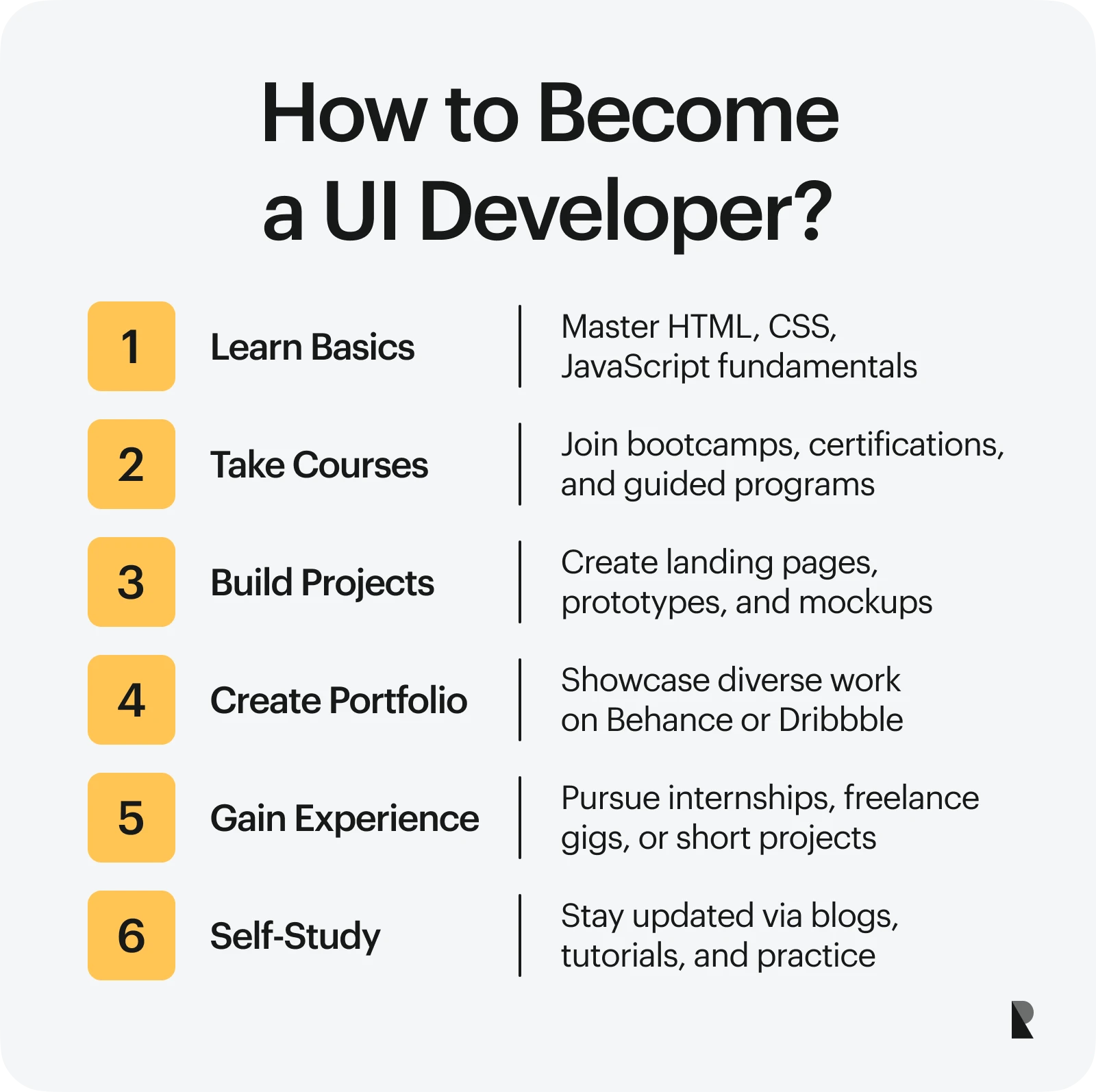
The following step-by-step guide can be a good starting point if you are an aspiring UI developer.
Learn the basics
The first step to becoming a UI developer is learning basic technical skills. These include programming languages such as HTML, CSS, and JavaScript. These languages are the backbone of any development process.
Several resources can help you get started. For example, freeCodeCamp and W3Schools provide tutorials and courses to learn these critical languages.
Take courses and bootcamps
Along with tutorials on programming languages, several platforms offer structured programs, such as certifications and boot camps, that help designers acquire the skills and credentials to be competitive in the market.
Some important examples include Coursera’s Web Design for Everybody and Udemy’s User Interface Design Courses. Such programs include helpful materials and hands-on experience in the form of small projects, thus aiding the overall learning process.
Build small projects
A UI developer’s resume always needs practical experience. This is where small design assignments and projects come in handy. To be competitive in the UI design and development market, you should have some projects to showcase your skills.
These projects can be small samples of your work, such as landing page designs, mobile application prototypes, and interface mockups. Their primary purpose is to demonstrate your skills.
Create a portfolio
A UI developer needs a well-designed, strong portfolio to impress the hiring managers. A good portfolio has a variety of projects, showcasing different skills. It is important to include examples of work in the form of screenshots, interactive prototypes, and live links.
Aspiring UI developers can use platforms such as Behance and Dribbble to quickly and efficiently create a professional portfolio. A good portfolio helps developers showcase their skills and land better opportunities.
Get internships or freelance gigs
One way to get professional experience and make some money along the way is to look for internships and freelance gigs. Several organizations are looking for UI developers who can work on short-term projects. Such positions can provide good entry points into the industry.
UI developers can use Fiverr, Upwork, and Toptal platforms to seek freelance gigs. Even though freelance projects are small, they can provide critical learning, such as new design requirements, incorporating feedback, and collaborative workflows.
Additional recommendations: self-study and certifications
Like any design and development role, UI development requires self-study and motivation from aspirants. Resources such as CSS-Tricks, Smashing Magazine, and YouTube tutorials on design topics can be helpful for UI developers.
Additionally, certifications such as the Google UX Design Certificate are helpful for learning the necessary skills and getting validation from established organizations.
Conclusion
UI development is crucial for designing interactive, user-friendly interfaces and shaping the user experience. Whether designing websites, web applications, mobile applications, or software programs, UI developers implement intuitive and responsive interfaces.
A strong, well-designed UI not only improves users' lives by enhancing their user experience but also benefits the business. Organizations that invest in UI development get better customer engagement and satisfaction owing to their high-quality designs. Additionally, good designs also improve customer loyalty, thus directly impacting a business's reach and success.
Developers with the necessary UI skills can add significant value to any organization or design agency. For anyone considering a career in UI development, now is an exciting time to enter the field. With the help of a diverse skillset and practical experience, aspiring UI developers can create a strong portfolio and become more marketable.
Sep 9, 2025
